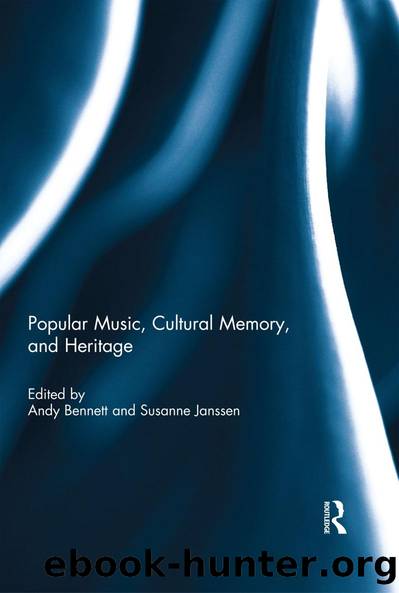Popular Music, Cultural Memory, and Heritage by Andy Bennett Susanne Janssen

Author:Andy Bennett, Susanne Janssen [Andy Bennett, Susanne Janssen]
Language: eng
Format: epub
ISBN: 9780367143091
Barnesnoble:
Publisher: Taylor & Francis
Published: 2019-01-17T00:00:00+00:00
an open collective that everyone can join! special singing talent is not a precondition! we sing in different languages and expand our repertoire constantly! the fun in singing together revolutionary, workersâ and partisan songs is important, as well as joining different projects and initiatives. (http://hor29n.wordpress.com/about)
As an activist collective encompassing multiple generations with diverse social and cultural backgrounds, the choir meets once a week for a two-hour singing practice at the âIntegrationshausâ (Integration House) in Vienna, a city organization that offers counseling and assistance to migrants, refugees, and asylum-seekers as well as a multitude of educational and cultural projects. The choir has an informal relationship with this organization, since it was an important contact point for some choir members after their immigration to Austria. The majority of the members appear regularly at the rehearsals throughout the year, while some come occasionally and a few attend only the choirâs public appearances.
This collective and grass-roots organizational structure of Hor 29 Novembar reflects a âparticipation-oriented type of migrant self-organization in the cultural fieldâ (Bratic 525) characterized, among other criteria, by the ethnic heterogeneity of the group, the production of social networks, and a high level of political motivation to bring about social change. In Austria, this form of migrant self-organization developed in the late 1990s, subsequent to the self-organization of the first generation of migrants from the former Yugoslavia and Turkey, who were recruited as âguest workersâ by the Austrian government in the 1960s. This first generation founded cultural initiatives and sport and workersâ clubs, in which about 50% of migrants in Austria were organized, aimed mainly at maintaining the cultural identity of the countries of origin, which provided them âwith stable, unchanging and continuous frames of reference and meaningâ (Hall, âCulturalâ 392). Defined by âonenessâ and an âimaginative rediscoveryâ of the past, as Hall characterizes this more traditional variant of cultural identity of diaspora groups, the cultural identity of the first generation of migrants reflects the shared cultural codes of their countries of origin as well as the common experiences of living as âguest workersâ in Austria, and as a result it played a crucial role in the formation of a political subject in the struggle for permanent residency and an unlimited access to the Austrian labor market.
The collective cultural identity of Hor 29 Novembar, by contrast, amounts to âa production of identityâ (Hall, âPolitical Belongingâ) or a âpost-identity,â as Hall also dubbed this variant of cultural identity that stresses notions of identification and belonging, which are multiple, fluid, and changing in relation to both the past and the present.1 The choir thus favors a migrant self-organization fostering participation and providing opportunities to exchange knowledge and memories with people of diverse social and cultural backgrounds. The knowledge acquired by the majority of the choir members through their activities in the (post-)punk scenes in their countries of origin in the 1980s and the DIY politics associated with these music scenes play a crucial role in the choirâs self-definition and self-understanding, as demonstrated in the
Download
This site does not store any files on its server. We only index and link to content provided by other sites. Please contact the content providers to delete copyright contents if any and email us, we'll remove relevant links or contents immediately.
Aircraft Design of WWII: A Sketchbook by Lockheed Aircraft Corporation(32139)
The Great Music City by Andrea Baker(30784)
Call Me by Your Name by André Aciman(19904)
The Art of Boudoir Photography: How to Create Stunning Photographs of Women by Christa Meola(18409)
The Secret History by Donna Tartt(18168)
Shoot Sexy by Ryan Armbrust(17558)
Plagued by Fire by Paul Hendrickson(17112)
Portrait Mastery in Black & White: Learn the Signature Style of a Legendary Photographer by Tim Kelly(16873)
Adobe Camera Raw For Digital Photographers Only by Rob Sheppard(16797)
Photographically Speaking: A Deeper Look at Creating Stronger Images (Eva Spring's Library) by David duChemin(16500)
Ready Player One by Cline Ernest(13995)
Pimp by Iceberg Slim(13781)
Bombshells: Glamour Girls of a Lifetime by Sullivan Steve(13687)
The Goal (Off-Campus #4) by Elle Kennedy(13203)
Art Nude Photography Explained: How to Photograph and Understand Great Art Nude Images by Simon Walden(12853)
Kathy Andrews Collection by Kathy Andrews(11328)
The Priory of the Orange Tree by Samantha Shannon(8618)
Thirteen Reasons Why by Jay Asher(8457)
The remains of the day by Kazuo Ishiguro(8397)
